Adding to loan loss reserves
SNL Report: Provisioning up again in Q4'14, expected to drag on bank earnings in '15
- |
- Written by SNL Financial

By Robin Majumdar and Zach Fox, SNL Financial staff writers
Loan loss provisioning increased year over year in the last three months of 2014 for the second quarter in a row, cementing the view among some analysts that provisions will be a headwind for bank earnings in 2015.
After increasing by nearly 30% year over year in the 2014 third quarter, commercial banks again posted higher provisions in the 2014 fourth quarter, setting aside $7.19 billion, compared to $6.40 billion in the prior-year period.
What’s behind the numbers?
The increase in provisioning does not appear to be driven by any sort of deterioration in credit quality, as net charge-offs were a mere 0.47% of average loans during the 2014 fourth quarter, down from 0.61% in the 2013 fourth quarter.
However, the charge-off rate did tick up by 2 basis points on a linked-quarter basis. Nonetheless, the increase in provisioning outstripped the uptick in charge-offs, pushing up the ratio of provisions to net charge-offs to 78% in the 2014 fourth quarter from 75% in the 2014 third quarter and 58% in the 2013 fourth quarter.
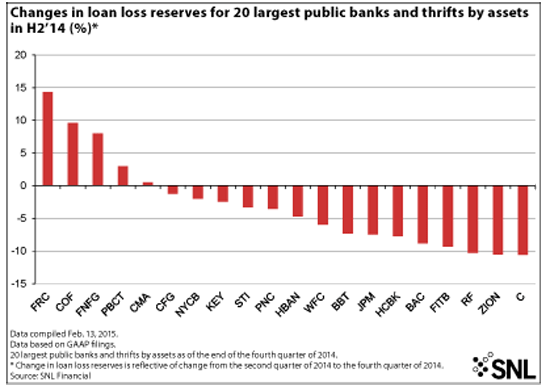 For a larger version, click on the image.
For a larger version, click on the image.
Following an era in which banks had been able to boost earnings by releasing loan loss reserves built up due to the 2008 credit crisis, some analysts now see provisions acting as an earnings drag for many banks.
Beyond the trend already reported in 2014 fourth-quarter results, BMO Capital Markets analysts Lana Chan and Peter Winter said in a Feb. 3 note that the latest senior loan officers survey suggests the trend of more provisioning will continue through the year due to only modest improvement in credit quality as loan growth continues and lenders ease underwriting standards.
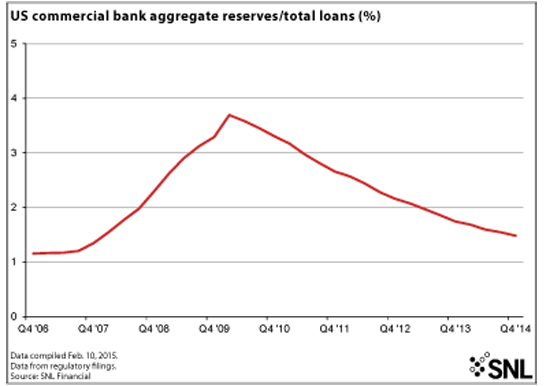 For a larger version, click on the image.
For a larger version, click on the image.
Provisions "should be an earnings headwind in 2015 even if [net charge-offs] remain below normalized levels, driven by less reserve releases," the analysts wrote.
In the 2014 fourth quarter, commercial banks indeed reported higher provisions while net income declined to $33.82 billion from $37.08 billion in the 2013 fourth quarter.
Trends within the trend
Still, the increase in provisioning was small enough that loan loss reserves continued to decline in aggregate during the 2014 fourth quarter, dropping to $113.11 billion from $115.73 billion in the 2014 third quarter and $126.57 billion in the 2013 fourth quarter. But not all banks are allowing aggregate reserves to shrink, with five of the top 20 banks by asset size reporting increases in aggregate loan loss reserves over the course of the 2014 second half.
By percentage gain, First Republic Bank reported the largest increase in aggregate reserves over the 2014 second half, growing by 14.36%. But that appeared to be largely a function of the bank's low base of reserves. Known for its high credit quality, First Republic's reserves were still low by industry standards at 0.54% of loans in the 2014 fourth quarter.
"We do expect to continue building the reserve as we go through 2015," said CFO Michael Roffler during First Republic's conference call to discuss 2014 fourth-quarter results. "We've been pretty consistent in terms of the reserves to the new loans since we divested from [Bank of America Corp.] of 55 to 60 basis points. … And we think that's a good place for us to be, given the credit quality of the portfolio today."
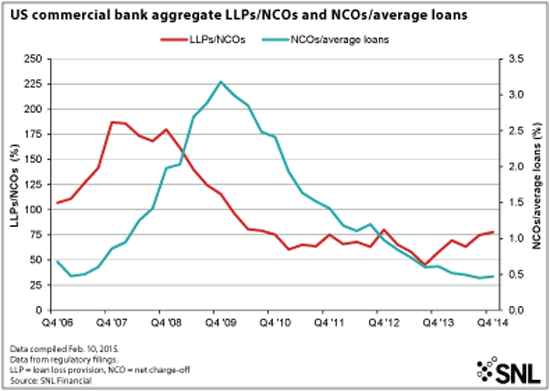 For a larger version, click on the image.
For a larger version, click on the image.
First Republic's net charge-offs supported the narrative, coming in at just 0.02% in the quarter.
Only two other banks in the top 20 posted aggregate reserve increases of greater than 5% in the 2014 second half: First Niagara Financial Group Inc. and Capital One Financial Corp.
First Niagara's aggregate reserves shot up in the 2014 third quarter, a rough one for the bank, when it set aside $45 million as a reserve for a deposit processing issue. Overall, the bank's aggregate reserves increased by 8% in the 2014 second half. The bank reversed $23 million of that reserve in the 2014 fourth quarter after gathering more data on the problem.
But that benefit was partially offset by a $5 million reserve added in the 2014 fourth quarter to account for the bank's estimated exposure to the oil and gas industry, said First Niagara CFO Gregory Norwood on the company's 2014 fourth-quarter earnings call.
The bank's handling of the deposit process issue appeared to placate analyst concerns, based on some reports filed after the company's earnings call. In a Jan. 26 note, Evercore Partners Inc. analyst John Pancari wrote that the bank's approach had tempered concerns over the issue. However, he also noted that the remediation plan was now in regulators' hands and that "such regulatory outcome/implications remains uncertain." Further, he said the company continued to face margin pressure.
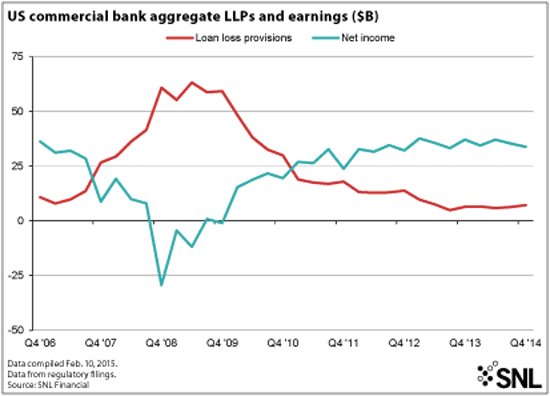 For a larger version, click on the image.
For a larger version, click on the image.
With a more optimistic view of the company, equity analysts at Jefferies upgraded their recommendation on First Niagara's stock to "buy" from "hold" in a Jan. 26 note. The analysts pointed to the company's strategic improvement plan. So far, the plan has been a drag on earnings, but the analysts foresee "an inflection point coming this year with program costs cresting and revenue generation potentially arriving in 4Q."
Finally, Capital One reported an increase in aggregate loan loss reserves of 9.63% over the course of the 2014 second half. Several analysts saw the increase as a significant drag on the company's ability to drive earnings in 2015. In a Jan. 28 note, Guggenheim Securities analysts Eric Wasserstrom downgraded the stock to "neutral." The downgrade was largely due to the company's restructuring opportunities approaching an end, with future progress hampered by larger provisioning.
Along with the downgrade, Wasserstrom reduced the 2015 full-year EPS estimate for Capital One to $7.15 from $7.85. "The primary driver of this reduction is higher provision expense, reflecting our outlook for a moderate increase in NCOs and the rebuilding of credit reserves to reflect the higher losses, the tenuring of recent card loan vintages, and further growth in assets," he wrote.
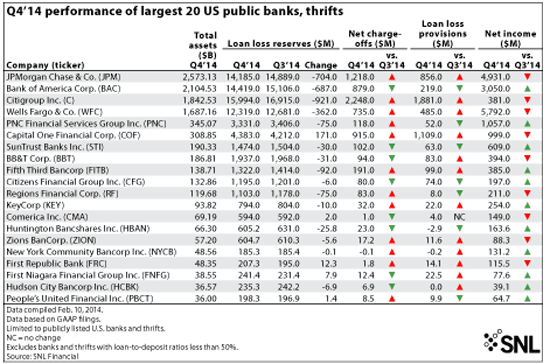 For a larger version, click on the image.
For a larger version, click on the image.
Jefferies analysts John Hecht and Kyle Joseph were slightly more optimistic on Capital One, though they also thought provisioning would be a drag on earnings moving forward. In a Jan. 23 note, the analysts lowered their price target for Capital One to $84.00 from $87.00 in a Jan. 23 note, projecting 2015 full-year EPS of $7.65.
"While we do not believe credit is deteriorating meaningfully, but rather reverting to the mean, we note it has transitioned to a definitive headwind for COF as well as other credit card issuers," the analysts wrote.
The topic of provisioning prompted a few analyst questions during Capital One's conference call to discuss 2014 fourth-quarter results. Goldman Sachs analyst Ryan Nash said it was the second quarter in a row that provisions came in higher than some analysts had expected.
"We're not trying to be difficult," said Capital One CFO Stephen Crawford, according to the transcript. "It's just—out beyond, particularly, your delinquency roll rates—I think it's very hard to predict credit from a quarter-to-quarter basis. So in general one can think a little bit how the balances are growing, as being the first factor, and a trend rate in losses being a second factor, but even that's not enough, because our balanced growth quarter to quarter has a seasonal component."














